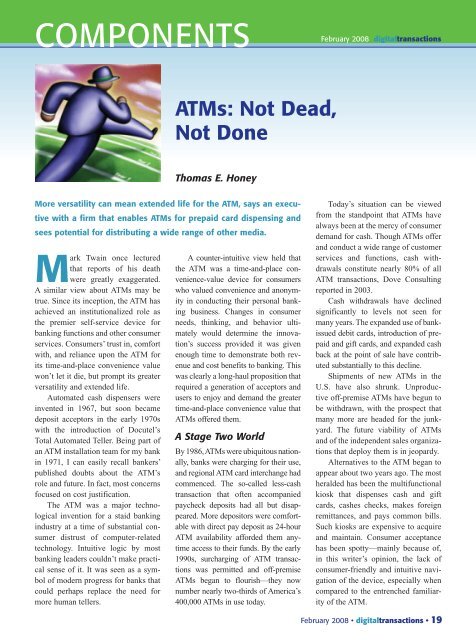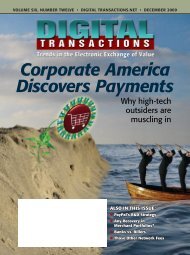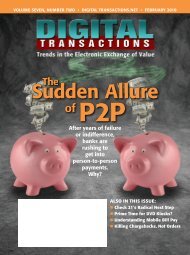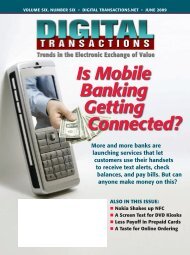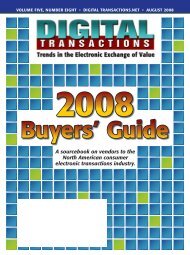The Broken Link - Digital Transactions
The Broken Link - Digital Transactions
The Broken Link - Digital Transactions
Create successful ePaper yourself
Turn your PDF publications into a flip-book with our unique Google optimized e-Paper software.
COMPONENTS<br />
February 2008 digitaltransactions<br />
ATMs: Not Dead,<br />
Not Done<br />
Thomas E. Honey<br />
More versatility can mean extended life for the ATM, says an executive<br />
with a firm that enables ATMs for prepaid card dispensing and<br />
sees potential for distributing a wide range of other media.<br />
Mark Twain once lectured<br />
that reports of his death<br />
were greatly exaggerated.<br />
A similar view about ATMs may be<br />
true. Since its inception, the ATM has<br />
achieved an institutionalized role as<br />
the premier self-service device for<br />
banking functions and other consumer<br />
services. Consumers’ trust in, comfort<br />
with, and reliance upon the ATM for<br />
its time-and-place convenience value<br />
won’t let it die, but prompt its greater<br />
versatility and extended life.<br />
Automated cash dispensers were<br />
invented in 1967, but soon became<br />
deposit acceptors in the early 1970s<br />
with the introduction of Docutel’s<br />
Total Automated Teller. Being part of<br />
an ATM installation team for my bank<br />
in 1971, I can easily recall bankers’<br />
published doubts about the ATM’s<br />
role and future. In fact, most concerns<br />
focused on cost justification.<br />
<strong>The</strong> ATM was a major technological<br />
invention for a staid banking<br />
industry at a time of substantial consumer<br />
distrust of computer-related<br />
technology. Intuitive logic by most<br />
banking leaders couldn’t make practical<br />
sense of it. It was seen as a symbol<br />
of modern progress for banks that<br />
could perhaps replace the need for<br />
more human tellers.<br />
A counter-intuitive view held that<br />
the ATM was a time-and-place convenience-value<br />
device for consumers<br />
who valued convenience and anonymity<br />
in conducting their personal banking<br />
business. Changes in consumer<br />
needs, thinking, and behavior ultimately<br />
would determine the innovation’s<br />
success provided it was given<br />
enough time to demonstrate both revenue<br />
and cost benefits to banking. This<br />
was clearly a long-haul proposition that<br />
required a generation of acceptors and<br />
users to enjoy and demand the greater<br />
time-and-place convenience value that<br />
ATMs offered them.<br />
A Stage Two World<br />
By 1986, ATMs were ubiquitous nationally,<br />
banks were charging for their use,<br />
and regional ATM card interchange had<br />
commenced. <strong>The</strong> so-called less-cash<br />
transaction that often accompanied<br />
paycheck deposits had all but disappeared.<br />
More depositors were comfortable<br />
with direct pay deposit as 24-hour<br />
ATM availability afforded them anytime<br />
access to their funds. By the early<br />
1990s, surcharging of ATM transactions<br />
was permitted and off-premise<br />
ATMs began to flourish—they now<br />
number nearly two-thirds of America’s<br />
400,000 ATMs in use today.<br />
Today’s situation can be viewed<br />
from the standpoint that ATMs have<br />
always been at the mercy of consumer<br />
demand for cash. Though ATMs offer<br />
and conduct a wide range of customer<br />
services and functions, cash withdrawals<br />
constitute nearly 80% of all<br />
ATM transactions, Dove Consulting<br />
reported in 2003.<br />
Cash withdrawals have declined<br />
significantly to levels not seen for<br />
many years. <strong>The</strong> expanded use of bankissued<br />
debit cards, introduction of prepaid<br />
and gift cards, and expanded cash<br />
back at the point of sale have contributed<br />
substantially to this decline.<br />
Shipments of new ATMs in the<br />
U.S. have also shrunk. Unproductive<br />
off-premise ATMs have begun to<br />
be withdrawn, with the prospect that<br />
many more are headed for the junkyard.<br />
<strong>The</strong> future viability of ATMs<br />
and of the independent sales organizations<br />
that deploy them is in jeopardy.<br />
Alternatives to the ATM began to<br />
appear about two years ago. <strong>The</strong> most<br />
heralded has been the multifunctional<br />
kiosk that dispenses cash and gift<br />
cards, cashes checks, makes foreign<br />
remittances, and pays common bills.<br />
Such kiosks are expensive to acquire<br />
and maintain. Consumer acceptance<br />
has been spotty—mainly because of,<br />
in this writer’s opinion, the lack of<br />
consumer-friendly and intuitive navigation<br />
of the device, especially when<br />
compared to the entrenched familiarity<br />
of the ATM.<br />
February 2008 • digitaltransactions • 19


